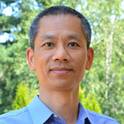Article
Modeling the Relationships Between Land Use and Land Cover on Private Lands in the Upper Midwest, USA
Journal of Environmental Management
(2000)
Abstract
This paper presents an approach to modeling land-cover change as a function of land-use change. We argue that, in order to model the link between socio-economic change and changes in forest cover in a region that is experiencing residential and recreational development and agricultural abandonment, land-use and land-cover change need to be represented as separate processes. Forest-cover change is represented here using two transition probabilities that were calculated from Landsat imagery and that, taken together, describe a Markov transition matrix between forest and non-forest over a 10-year period. Using a three-date land-use data set, compiled and interpreted from digitized parcel boundaries, and scanned aerial photography for 136 sites (c. 2500 ha) sampled from the Upper Midwest, USA, we test functional relationships between forest-cover transition probabilities, standardized to represent changes over a decade, and land-use conditions and changes within sample sites. Regression models indicated that about 60% of the variation in the average forest-cover transition probabilities (i.e. from forest to non-forest and vice versa) can be predicted using three variables: amount of agricultural land use in a site; amount of developed land use; and the amount of area increasing in development. In further analysis, time lags were evaluated, showing that agricultural abandonment had a relatively strong time-lag effect but development did not. We demonstrate an approach to using forest-cover transition probabilities to develop spatially-constrained simulations of forest-cover change. Because the simulations are based on transition probabilities that are indexed to a particular time and place, the simulations are improved over previous applications of Markov transition models. This modeling approach can be used to predict forest-cover changes as a result of socio-economic change, by linking to models that predict land-use change on the basis of exogenous human-induced drivers.
Disciplines
Publication Date
2000
Publisher Statement
Copyright (2000) Elsevier
*At the time of publication, Jiunn-Der Duh was affiliated with University of Michigan.
Citation Information
Brown, D. G., Pijanowski, B. C., & Duh, J. D. (2000). Modeling the relationships between land use and land cover on private lands in the Upper Midwest, USA. Journal of Environmental Management, 59(4), 247-263.
